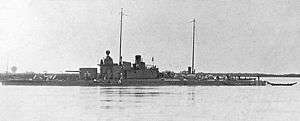Enns-class river monitor
 SMS Enns | |
| Class overview | |
|---|---|
| Name: | Sava |
| Builders: | |
| Operators: | |
| Preceded by: | Temes class |
| Succeeded by: | Sava class |
| Built: | 1912–1915 |
| In service: | 1914–1958 |
| Completed: | 2 |
| Lost: | 1 |
| Retired: | 1 |
| General characteristics | |
| Type: | River monitor |
| Displacement: | 540 tonnes (530 long tons) |
| Length: | 57.9 m (190 ft 0 in) |
| Beam: | 10.3 m (33 ft 10 in) |
| Draught: | 1.3 m (4 ft 3 in) |
| Installed power: |
|
| Propulsion: | 2 Triple-expansion steam engines |
| Speed: | 13 knots (24 km/h; 15 mph) |
| Complement: | 95 officers and enlisted men |
| Armament: |
|
| Armour: |
|
The Enns-class river monitors were built for the Austro-Hungarian Navy during the mid-1910s. The two ships of the class were assigned to the Danube Flotilla and participated in World War I. The ships survived the war and were transferred to Romania and the newly created Kingdom of Serbs, Croats and Slovenes (later Yugoslavia) as reparations.
Description and construction
The ships had an overall length of 57.9 m (190 ft 0 in), a beam of 10.3 m (33 ft 10 in), and a normal draught of 1.3 m (4 ft 3 in). They displaced 540 tonnes (530 long tons), and their crew consisted of 95 officers and enlisted men.[1] The Enns-class ships were powered by two triple-expansion steam engines, each driving one shaft, using steam generated by two Yarrow boilers driving.[1] The engines were rated at 1,500–1,700 indicated horsepower (1,100–1,300 kW) and were designed to reach a top speed of 13.5 knots (25.0 km/h; 15.5 mph). They carried 75 long tons (76 t) of fuel oil.[2]
The main armament of the Enns-class river monitors was a pair of 120 mm (4.7 in)/L45[lower-alpha 1] guns in a single turret forward of the conning tower and three 120 mm (4.7 in)/L10 howitzers to the rear, in individual armored cupolas. They also mounted two individual 66 mm (2.6 in)/L50 BAG anti-aircraft guns, and six machine guns.[1] The maximum range of her Škoda 120 mm (4.7 in)L/45 guns was 15 kilometres (9.3 mi).[3] Her armour consisted of belt and bulkheads 40 mm (1.6 in) thick, deck armour 25 mm (0.98 in) thick, and her conning tower, gun turrets and cupolas were 50 mm (2.0 in) thick.[1]
Ships
| Ship | Builder[1] | Laid down[1] | Launched[1] | Commissioned[1] | Fate |
|---|---|---|---|---|---|
| Drava | Stabilimento Tecnico Triestino, Linz | 1912 | September 1914 | 17 October 1914 | Scuttled, 11/12 April 1941[4] |
| Besarabia | Ganz Danubius, Budapest | 1913 | 25 February 1915 | 11 April 1915 | Scrapped? |
Notes
- ↑ L/45 denotes the length of the gun. In this case, the L/45 gun is calibre, meaning that the gun was 45 times as long as the diameter of its bore.
Footnotes
- 1 2 3 4 5 6 7 8 Greger 1976, p. 142.
- ↑ Jane's Information Group 1989, p. 315.
- ↑ Greger 1976, p. 9.
- ↑ Chesneau 1980, p. 357.
References
- Chesneau, Roger, ed. (1980). Conway's All the World's Fighting Ships, 1922–1946. London, England: Conway Maritime Press. ISBN 978-0-85177-146-5.
- Gardiner, Robert, ed. (1985). Conway's All the World's Fighting Ships, 1906–1921. London, England: Conway Maritime Press. ISBN 978-0-85177-245-5.
- Greger, René (1976). Austro-Hungarian Warships of World War I. London, England: Allan. ISBN 978-0-7110-0623-2.
- Halpern, Paul G. (2012). A Naval History of World War I. Annapolis, Maryland: Naval Institute Press. ISBN 978-0-87021-266-6.
- Jane's Information Group (1989) [1946/47]. Jane's Fighting Ships of World War II. London, England: Studio Editions. ISBN 978-1-85170-194-0.
- Jane's Information Group (1990) [1919]. Jane's Fighting Ships of World War I. London, England: Studio Editions. ISBN 978-1-85170-378-4.
- Marshall, Chris (1995). The Encyclopedia of Ships : The History and Specifications of Over 1200 Ships. New York: Barnes & Noble. ISBN 978-1-56619-909-4.
- Niehorster, Dr. Leo (2013). "Balkan Operations Order of Battle Royal Yugoslavian Navy River Flotilla 6th April 1941". Dr. Leo Niehorster. Retrieved 23 May 2014.
- Shores, Christopher F.; Cull, Brian; Malizia, Nicola (1987). Air War for Yugoslavia, Greece, and Crete, 1940–41. London: Grub Street. ISBN 978-0-948817-07-6.
- Terzić, Velimir (1982). Slom Kraljevine Jugoslavije 1941 : uzroci i posledice poraza [The Collapse of the Kingdom of Yugoslavia in 1941: Causes and Consequences of Defeat] (in Serbo-Croatian). 2. Belgrade, Yugoslavia: Narodna knjiga. OCLC 10276738.